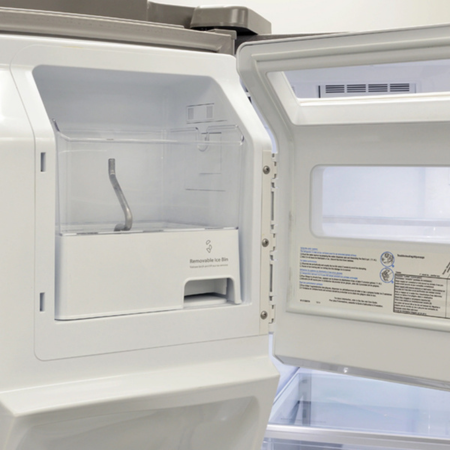Whirlpool refrigerators are renowned for their reliability and longevity, but like every appliance, they can run into occasional hitches.
One common issue users often encounter is the fridge’s inability to produce ice.
Such a problem could arise for numerous reasons, including a defective water inlet valve, a clogged filter, or a malfunctioning ice maker assembly.
This document aims to provide a comprehensive guide to diagnosing and fixing the issue of your Whirlpool fridge not making ice.
With this guide, you’ll be equipped with the knowledge to troubleshoot and possibly rectify the problem, saving you time and potentially costly repair fees.
Why Is My Whirlpool Fridge Not Making Ice?
Your Whirlpool fridge may stop making ice due to a variety of reasons. These issues often involve component failures or blockages that hinder the ice-making process. Here are the five most common causes:
1. Defective Water Inlet Valve
The water inlet valve is crucial for ice production. It supplies water to the ice maker. If this valve is defective, it might not supply enough water, or any water at all, leading to no ice production.
Sometimes, the valve might not open due to insufficient pressure. A minimum of 20 psi is required for the valve to function properly.
A defective valve can be identified using a multimeter. This device checks for continuity, a continuous electrical path in the valve. No continuity indicates a defective valve that should be replaced.
It’s important to note that the water inlet valve is connected to the household water supply line. To access it, you must disconnect the refrigerator from the power source and turn off the water supply. Always exercise caution when attempting this task yourself.
2. Clogged Filter
A dirty or clogged filter is another common culprit when your Whirlpool fridge stops making ice. Over time, filters can become clogged with impurities from the water supply. This clog restricts water flow to the ice maker.
A clogged filter can lead to more than just ice-making issues. It may also affect the quality and taste of your water. For optimal performance, replace the water filter every six months or as instructed by the manufacturer.
Replacing the filter is generally a straightforward task. You can find it inside the fresh food compartment. Remove the old filter, insert the new one, and run a few gallons of water through it to prime it. Remember to dispose of the old filter responsibly.
If the issue persists after replacing the filter, it may be time to consider other potential issues with the ice maker.
3. Faulty Ice Maker Assembly
The ice maker assembly might be faulty if the fridge isn’t making ice. Problems can range from minor component faults to total failure. Unfortunately, it’s hard to determine the exact issue without proper tools and know-how.
Ice maker assemblies have various components. These include the ice mold, the control module, and the water fill system. If one component fails, the entire assembly might stop working.

It’s challenging to fix a faulty ice maker assembly at home. Trying to repair complex electrical components can be hazardous. Additionally, you might inadvertently cause more damage.
Consider hiring a professional if you suspect an assembly issue. They can diagnose and fix the problem safely and efficiently. You’ll also preserve the warranty on your refrigerator. Don’t forget to check the warranty before attempting any repairs yourself.
4. Malfunctioning Thermostat
A thermostat that isn’t functioning correctly can also affect your fridge’s ice-making capability. The thermostat regulates the temperature inside the freezer. If it’s not working, the temperature might be too high for the ice maker to operate.
This can be a tricky issue to identify. A faulty thermostat can sometimes cause inconsistent cooling. You might notice that your freezer is colder than usual, or not as cold as it should be.
It’s not recommended to fix a malfunctioning thermostat yourself. It’s a delicate component and requires a professional touch.
If you suspect a thermostat issue, it’s best to get a professional appliance repair service involved. This ensures the safety, efficiency, and preservation of your warranty.
5. Blocked Fill Tube
The fill tube carries water from the fill valve to the ice maker assembly. The water can’t reach the ice maker if there’s a blockage. This might be why your refrigerator isn’t making ice.
Common causes of a blocked fill tube include a frozen water line or a clogged filter. Both issues are relatively easy to identify. If ice is the culprit, you’ll see a buildup in the tube. A clogged filter, on the other hand, can reduce water flow to a trickle.
Fixing a blocked fill tube is a manageable DIY task. You can use a hairdryer to thaw it out if it’s a frozen line.
If it’s a clogged filter, replace it. Always consult your refrigerator’s user manual for guidance. If you’re unsure, call a professional. It’s better to be safe than sorry.
How To Troubleshoot Whirlpool Fridge Not Making Ice?
Troubleshooting a Whirlpool fridge not making ice involves several steps:
- Check the Water Supply Line: Ensure it isn’t kinked or blocked. This could hinder water flow to the ice maker.
- Examine the Ice Maker Switch: Make sure it’s turned on. Some Whirlpool models have a wire switch that needs to be lowered.
- Inspect the Freezer Temperature: It should be between 0-5 degrees Fahrenheit for the ice maker to function. Use a fridge thermometer to check.
- Evaluate the Ice Maker Assembly: Look for potential ejector blades or gear faults. If these are broken, replace the assembly.
- Review the Water Inlet Valve: If it’s defective or insufficient water pressure is present, the valve may not open. This prevents water from reaching the ice maker.

Always remember to unplug your fridge before troubleshooting. This ensures your safety. If these steps don’t resolve the issue, it’s best to call a professional.
Frequently Asked Questions
Why is my Whirlpool fridge not producing ice?
There could be several reasons why your Whirlpool fridge isn’t producing ice. Often, the issue lies with the ice maker assembly, water inlet valve, or the water filter. If any of these components fail or become clogged, it could prevent ice production.
The freezer temperature should also be set between 0-5 degrees Fahrenheit. The ice maker may not produce ice if it’s above 10 degrees Fahrenheit. It’s best to consult with a certified appliance repair professional to diagnose and fix the issue accurately.
What could be the potential causes behind the ice maker failure in my Whirlpool fridge?
The failure of the ice maker in your Whirlpool fridge could be due to several factors. One common reason is a malfunctioning water inlet valve, which may not allow water to reach the ice maker.
Another common issue is a faulty ice maker assembly or switch. Problems with the freezer’s thermostat could also affect ice production because the temperature needs to be just right for the process to occur.
Finally, a clogged or improperly installed water filter could restrict water flow to the ice maker. Always ensure that regular maintenance checks are carried out for optimal performance.
How can I troubleshoot the ice maker issue in my Whirlpool fridge?
Start by checking the temperature of your freezer – it should be between 0-5 degrees Fahrenheit for optimal ice production. Next, inspect the water inlet valve for any signs of damage or clogging. If your fridge has a water filter, ensure it’s not clogged and is properly installed.
Examine the ice maker assembly and switch to see if they function correctly. If you’re unsure about any of these steps, it’s best to call a professional. Regular maintenance can help prevent these issues and ensure your ice maker continues functioning efficiently.
When ice production stops, should I check any specific parts of my Whirlpool fridge?
Absolutely. When your Whirlpool fridge stops producing ice, you should check the freezer’s temperature initially. Ideally, the ice maker should be set between 0-5 degrees Fahrenheit to function properly. Then, inspect the water inlet valve for any signs of damage or clogging. The water filter should be checked for any blockages and ensure it is installed correctly.
Also, evaluate the ice maker assembly and switch to observe if they are in working condition. In case of any doubt or complexity, do not hesitate to seek professional help. Regular maintenance checks can help maintain the efficient functioning of the fridge.
What fixes can be implemented if my Whirlpool fridge is not making ice?
If your Whirlpool fridge isn’t making ice, there are a few fixes you could try. First, check the temperature settings of your freezer – it should be set between 0-5 degrees Fahrenheit. Second, inspect the water inlet valve for any signs of clogging or damage. If your fridge has a water filter, check it for blockages and ensure it’s properly installed.
Examine the ice maker assembly and switch to see if they function properly. Consulting with a professional is advisable if these steps don’t solve the issue. Regular maintenance checks can also help prevent these issues.
When should I consider professional help for my Whirlpool fridge’s ice maker issue?
Professional help should be considered when basic troubleshooting doesn’t resolve the ice maker issue. If you’ve performed all the suggested checks and the ice maker is still not functioning, it’s time to call a professional.
Technicians have the expertise to diagnose and rectify any complex problems. You should also consider professional help when the fridge is still under warranty to avoid inadvertently voiding it. Remember, attempting to solve complex issues without proper knowledge may lead to further complications, so it’s always best to seek professional assistance when in doubt.
Conclusion
A fridge not making ice can be a real inconvenience. But, with the right steps, you can troubleshoot the problem.
Check the water supply and ice maker switch.
Make sure the temperature is right. Inspect the ice maker assembly and water inlet valve. If these don’t fix it, call a pro.
Always prioritize your safety. Unplug the fridge before starting your investigation.
- Can You Put Microwave Popcorn In The Oven: Pros And Cons - May 14, 2024
- Can You Scrap A Microwave And Why You Should? - May 13, 2024
- Can You Put Metal In A Convection Microwave: 10 Major Risks - May 12, 2024

